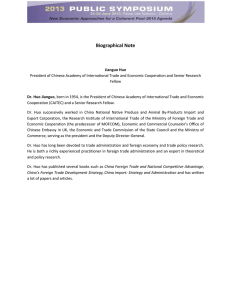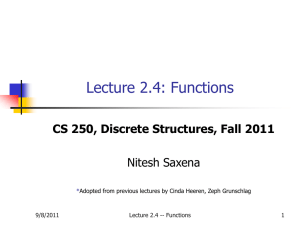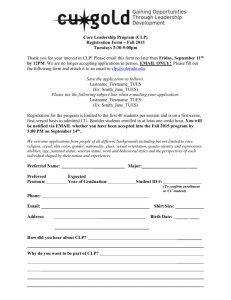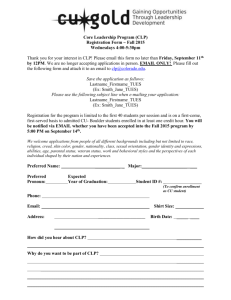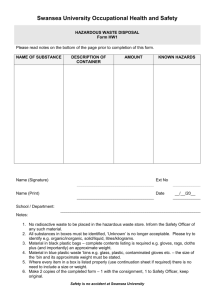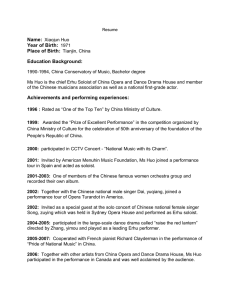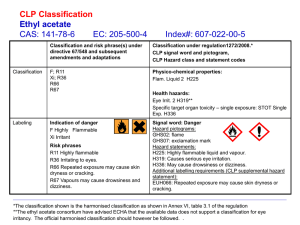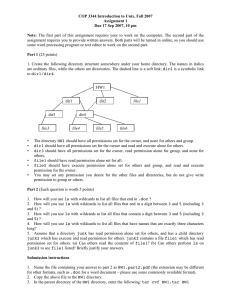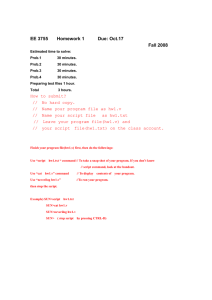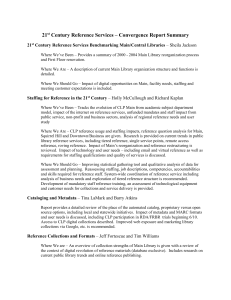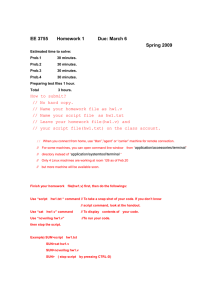Unconditional Models of Time on Your Own Data
advertisement
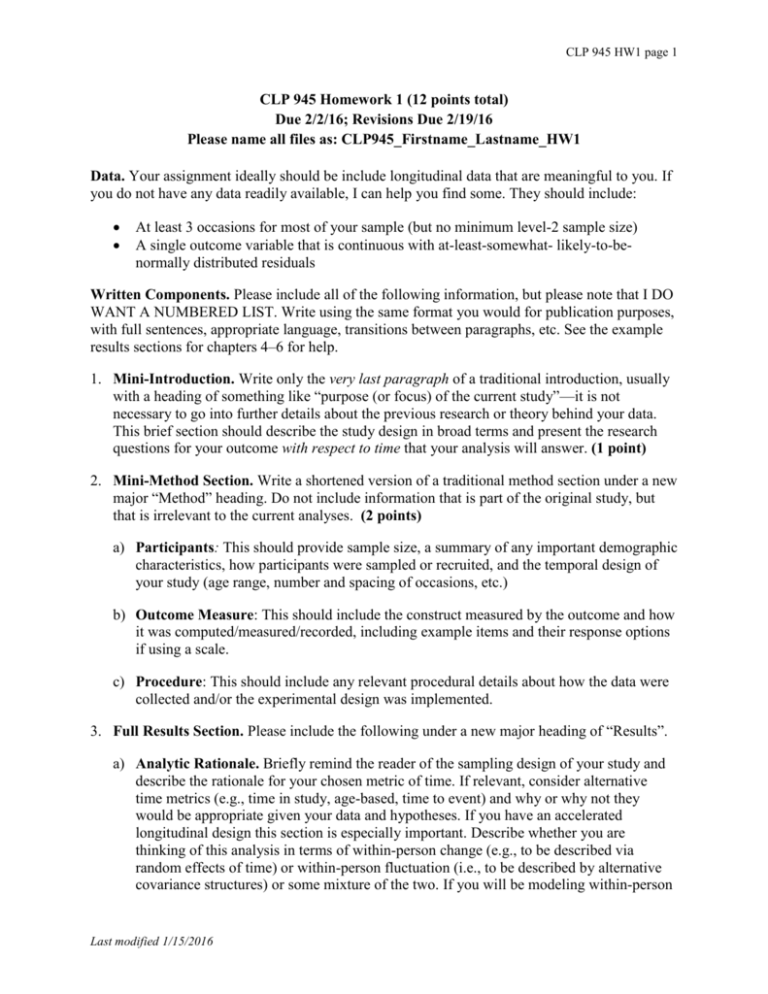
CLP 945 HW1 page 1 CLP 945 Homework 1 (12 points total) Due 2/2/16; Revisions Due 2/19/16 Please name all files as: CLP945_Firstname_Lastname_HW1 Data. Your assignment ideally should be include longitudinal data that are meaningful to you. If you do not have any data readily available, I can help you find some. They should include: At least 3 occasions for most of your sample (but no minimum level-2 sample size) A single outcome variable that is continuous with at-least-somewhat- likely-to-benormally distributed residuals Written Components. Please include all of the following information, but please note that I DO WANT A NUMBERED LIST. Write using the same format you would for publication purposes, with full sentences, appropriate language, transitions between paragraphs, etc. See the example results sections for chapters 4–6 for help. 1. Mini-Introduction. Write only the very last paragraph of a traditional introduction, usually with a heading of something like “purpose (or focus) of the current study”—it is not necessary to go into further details about the previous research or theory behind your data. This brief section should describe the study design in broad terms and present the research questions for your outcome with respect to time that your analysis will answer. (1 point) 2. Mini-Method Section. Write a shortened version of a traditional method section under a new major “Method” heading. Do not include information that is part of the original study, but that is irrelevant to the current analyses. (2 points) a) Participants: This should provide sample size, a summary of any important demographic characteristics, how participants were sampled or recruited, and the temporal design of your study (age range, number and spacing of occasions, etc.) b) Outcome Measure: This should include the construct measured by the outcome and how it was computed/measured/recorded, including example items and their response options if using a scale. c) Procedure: This should include any relevant procedural details about how the data were collected and/or the experimental design was implemented. 3. Full Results Section. Please include the following under a new major heading of “Results”. a) Analytic Rationale. Briefly remind the reader of the sampling design of your study and describe the rationale for your chosen metric of time. If relevant, consider alternative time metrics (e.g., time in study, age-based, time to event) and why or why not they would be appropriate given your data and hypotheses. If you have an accelerated longitudinal design this section is especially important. Describe whether you are thinking of this analysis in terms of within-person change (e.g., to be described via random effects of time) or within-person fluctuation (i.e., to be described by alternative covariance structures) or some mixture of the two. If you will be modeling within-person Last modified 1/15/2016 CLP 945 HW1 page 2 change, describe what kind of random effects change model you’ll be using (e.g., polynomials, pieces, nonlinear) and why you picked that family of models. Then say what software you used, what estimator you used, and any other relevant details about your modeling process. (2 points) b) Report and interpret the ICC from an empty means, random intercept model. (1 point) c) Next, if you have balanced data, estimate a saturated means, unstructured variance model for time. If time is unbalanced, you may round time into integers for the purposes of describing the data (but analyze time in its unrounded metric). If an unstructured variance model will not estimate, report this in the text and use a random intercept model instead. Describe the patterns you observe in terms of the means and variances over time as a precursor to the unconditional models of time you’ll report next. (1 point) d) Estimate sequential unconditional models for time, using alternative covariance structures, fixed and random effects of time, or any combination thereof that makes sense for your outcome. Make sure to document your decision-making process completely, and record relevant values in tables or in the text as needed (i.e., like the summary tables in chapters 4 for ACS models, or in chapter 6 for random effects models). If you are unsure what would be most appropriate for your outcome, PLEASE discuss with me which options make the most sense for your data. (3 points) e) For the final unconditional model selected, interpret each model parameter (i.e., its meaning within the metric of the original variables where possible). Provide and interpret 95% random effects confidence intervals for EACH random effect. Provide a table with clearly labeled parameter estimates, standard errors, and p-values from the final unconditional model (e.g., “UN(1,1)” is not a good label). (2 points) 4. Exhale and submit it! Please include not only your written document, but also the syntax and output for each reported model. Name each file as: CLP945_Firstname_Lastname_HW1. I cannot grade your work without all of these files for my reference, so please don’t forget! A few grammatical, style, or APA-related issues that have come up repeatedly in the past: Do not begin sentences with numbers, even in the method section. Do not use the phrase unit time ever—use the actual units instead (e.g., days, months, years). Affect can be a verb; effect is always a noun. The word data is plural. We do not calculate models; we estimate them. We do not run analyses; we conduct analyses or estimate models. Spell out all abbreviations in tables (perhaps in a footnote if running low on space). APA also discourages the use of author-defined acronyms, and so do I. One user-defined abbreviation per paper is probably the upper limit. A general rule is DO NOT MAKE YOUR READERS REMEMBER ANYTHING. Last modified 1/15/2016 CLP 945 HW1 page 3 Try to scale your variables such that the direction corresponds with their names. For example, if I have a variable called health but higher scores mean worse health, what I really have is a variable called sickness or lack of health. I would recommend either changing the name or flipping the direction so that they are congruent. Use the same terms to describe your constructs consistently throughout—synonyms might make your writing more interesting, but ultimately much less clear. Pick one name and stick with it. Avoid using this at the beginning of a sentence without a specific modifier. For example, rather than “This model fit better than the previous model,” try “the random linear time model fit better than the fixed linear time model.” Use parallel sentence structure whenever possible. For example, a non-parallel (and harder to follow) sentence would be something like “The intraclass correlation for Y was .50, and .30 was the intraclass correlation for X.” Keep the noun–verb pattern the same, as well as the direction. In general, the more formulaic (i.e., boring) your writing in methods and results sections, the easier they will be to understand. Save your creativity for the introduction and discussion. Last modified 1/15/2016
